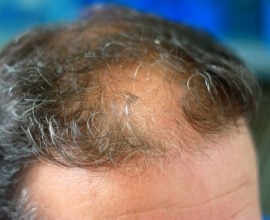Thinning Hair and What You Can Do About It
- What causes permanent hair loss?
- Medicinal treatment
- Hair transplant treatment
- Platelet-rich plasma treatment
Hair loss has many different causes, such as genetics, state of health, lifestyle habits and long-term stress, and any combination of these factors will certainly lead to male and female-pattern baldness. Here is a recap of the most common reasons why a person may experience loss of hair or thinning hair density, plus, what you can do about it.
What causes permanent hair loss?
Most cases of thinning hair occur in men and may be attributed to what is known as androgenetic alopecia, which causes the hair shaft itself to shrink and hair to lose density. It is a type of hormone-induced baldness that typically causes a man's hairline to recede at the temples but, for women, the symptoms involve a widened central hairline and possibly even coarse hair on the face. Some types of hair loss can start as early as in your teenage years, however, or occur with the onset of a disease like hypothyroidism, lupus or polycystic ovary syndrome (POSC). Medications can also cause hair thinning due to side-effects and, on some occasions, over styling or repetitively touching or pulling on hair may cause lasting damage.[1]
Medicinal treatment
Thinning hair will lead to permanent baldness if left neglected and, with a history of alopecia in the family, it may have already started to worry you early in life as this type of hair loss can start prematurely in your late teens. Taking over-the-counter medications like minoxidil or oral prescriptions like finasteride will maintain hair health or at least sustain it from losing any more density.[2] However, to regain hair or re-establish a youthful head of hair, just taking medications may not be enough over the years.

Hair transplant treatment
The most modern form of hair loss treatment on the market is minimally invasive and requires only a local anesthesia. While most commonly applicable to male-pattern baldness, treatment can fill in scarred patches on the head, eyebrows, beard or even restore eyelashes. A hair transplant procedure involving the most up-to-date SmartGraft® and ARTAS® robotic technology should last up to 7 hours, tallying up to only a day in the clinic. A doctor programs what will be the recipient area and the robot then calculates what distances should be kept between hair follicles as it transplants them. The extraction tool keeps grafts moistened and temperature controlled all while operating at a pace and with such microscopic precision that no doctor could ever match. As a hands-off and scalpel-free procedure, the fast recovery and improved look makes it worthwhile.
Platelet-rich plasma treatment
By the age of sixty, nearly half of all men and a third of women develop alopecia. Due to a limited number of effective treatments for balding and thinning hair, the effectiveness of platelet rich plasma (PRP) as an alternative therapy has recently grown traction. This is because the alpha granules of your platelets can stimulate stem cells in the bulge area of a hair follicle to regrow follicles and vascularize simultaneously. While the treatment seems incredibly promising, establishing a standardized method of evaluating results is still underway.[3]
Looking forward to developments in this field? We are too! That is why our clinic has implemented only the latest and most effective technology into our treatment plans.
Sources:
[1] Gardner , Amanda. “21 Causes of Hair Loss—And What You Can Do About It.” Health, Meredith Health Group, 23 Oct. 2019, www.health.com/beauty/21-causes-of-hair-loss-and-what-you-can-do-about-it.
[2] Feinstein, Robert P, and David F Butle. “Androgenetic Alopecia.” Medscape, WebMD LLC, 5 Mar. 2020, emedicine.medscape.com/article/1070167-overview.
[3] Stevens, J., and S. Khetarpal. “Platelet-Rich Plasma for Androgenetic Alopecia: A Review of the Literature and Proposed Treatment Protocol.” International Journal of Women's Dermatology, vol. 5, no. 1, Feb. 2019, pp. 46–51., doi:10.1016/j.ijwd.2018.08.004.














